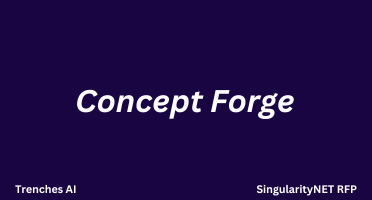
Anthony Oliko
Project OwnerLead the concept blending implementation, coordinate research activities, and ensure alignment with cognitive theories of creativity. Design the algorithms and supervise evaluation methodologies.
DEEP Connects Bold Ideas to Real World Change and build a better future together.
Coming Soon
ConceptForge advances the exploration of concept creation methods in the ecosystem by experimenting with novel concept generation methods and implementing them in MeTTa/Hyperon Framework. We combine information-theoretic concept blending with fuzzy and paraconsistent FCA to generate new concepts from existing knowledge, with algorithms optimized for the Hyperon framework. Our system features a dual-evaluation framework—human assessment plus LLM-based validation—to measure both creativity and effectiveness of generated concepts. This implementation will enhance Hyperon's cognitive capabilities while advancing fundamental research in computational creativity and concept formation for AGI.
This RFP seeks proposals that experiment with concept blending techniques and formal concept analysis (including fuzzy and paraconsistent variations) using the MeTTa programming language within OpenCog Hyperon. The goal is to explore methods for generating new concepts from existing data and concepts, and evaluating these processes for creativity and efficiency. Bids are expected to range from $30,000 - $60,000.
Detailed research plan outlining our approach to concept blending and FCA implementation in MeTTa. We will define specific algorithms evaluation methodologies and integration strategies with Hyperon. This phase includes literature review technical feasibility assessment and detailed architecture design.
1. Comprehensive technical specification document detailing algorithms for both concept blending and FCA implementations 2. Architecture design diagrams showing system components and their interactions 3. Evaluation framework specification including metrics and methodologies 4. Agile development plan with weekly sprints and task assignments 5. Risk assessment and mitigation strategies 6. Integration plan with Hyperon's Distributed Atomspace
$9,000 USD
Approval of research plan and architecture by SingularityNET technical team, confirming alignment with Hyperon roadmap and RFP requirements. The architecture must demonstrate feasibility through theoretical analysis and preliminary prototyping of critical components. Success metrics include clarity of algorithm specifications, completeness of evaluation framework, and detailed integration strategy.
Implementation of core concept generation algorithms and evaluation framework in MeTTa with preliminary testing on controlled datasets to validate approach and identify optimization opportunities.
1. Functional implementation of information-theoretic concept blending in MeTTa 2. Implementation of fuzzy and paraconsistent FCA algorithms 3. Prototype of LLM-based concept evaluation system 4. Integration with Hyperon's Atomspace for concept storage and retrieval 5. Test suite with sample concepts and expected outcomes 6. Technical documentation of implemented components 7. Initial performance analysis identifying bottlenecks and optimization opportunities
$18,000 USD
Successful demonstration of both concept blending and FCA algorithms generating novel concepts from test inputs. The system must achieve minimum performance benchmarks: concept generation latency under 5 seconds for simple inputs, successful Atomspace integration, and evaluation scores showing statistically significant correlation with human judgments of creativity. Initial testing must demonstrate at least three distinct concept generation patterns.
Complete all implementation components conduct comprehensive evaluation optimize performance and deliver final system with thorough documentation and demonstration materials.
1. Complete optimized implementation of ConceptForge system in MeTTa 2. Comprehensive evaluation results using multiple datasets 3. Performance analysis and benchmarking against baseline methods 4. User documentation and developer guides 5. Integration tests with other Hyperon components 6. Five demonstration applications showcasing concept generation capabilities 7. Video tutorials explaining system operation and theoretical foundations 8. Source code with extensive comments and unit tests 9. Final report documenting research findings and future directions
$18,000 USD
Full system functionality meeting all RFP requirements, with performance metrics exceeding baseline methods. The system must successfully generate novel, meaningful concepts as judged by both automated metrics and human evaluation. Documentation must be comprehensive enough for other researchers to understand and extend the system. At least three of the demonstration applications must show practical utility beyond mere concept generation, illustrating how the system enhances Hyperon's cognitive capabilities.
Reviews & Ratings
Please create account or login to write a review and rate.
Check back later by refreshing the page.
© 2025 Deep Funding
Join the Discussion (0)
Please create account or login to post comments.